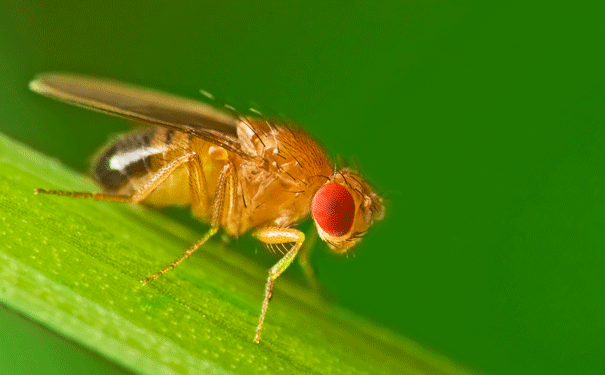
Studies usually focus on the male fruit fly (above) and ignore the females. Image: Studiotouch/Shutterstock
Men are from Mars, women are from Venus — and fruit fly neural circuits can prove it.
Fruit flies are often used to map neural elements that direct behaviour. This time, the dramatic changes of behaviour in the female fruit flies after sex could allow researchers to understand the different neural circuits of men and women.
Past studies have focused on the male fruit flies, while the females are ignored. “The male fruit fly is a big show off, always trying to impress the female with his elegant courtship display,” says University of Oxford researcher Dr Stephen Goodwin, one of the authors of the study published in Current Biology.
The female’s behaviours are more enigmatic during the courtship process, but Goodwin and his colleagues have shown she behaves very differently after mating. “We have exploited this complex behavioural change to explore how chemical signals passed between the sexes can trigger complex behaviours.”
Not surprisingly, reproduction behaviours in the fly, both pre- and post-mating, are focused on producing offspring. But the female’s behaviour undergoes a change after mating, moving from a receptive to a non-receptive state once she has successfully mated.
In this state, she actively rejects any further advances from the male, while changing her feeding and activity patterns. These behaviours are believed to have evolved to support accelerated ovulation and laying fertilised eggs.
“In flies, once the female has mated, something about her demeanour changes to make her less attractive to the male and focus on more maternal activities,” says lead post-doctoral researcher Dr Rezával.
A male sex peptide protein interacting with neurons in the female’s genital tract triggers these behaviours. The researchers have also defined the neural circuitry involved in processing this information and have begun mapping a complete female-specific behavioural circuit.
Apparently, it only takes two neuronal clusters being stimulated by the sex peptide to cause this shift in behaviours. The information is then transferred from the uterus via abdominal ganglia- which is the fly equivalent of a spinal cord- to alert the female of her new change in sex status.
This will cause her to modify her behaviour- the researchers found that this changes according to how much attention she is receiving and whether or not she is receptive to copulation. This will also modify the behaviour of any potential suitors.
“We have now identified more elements of the fly circuitry that underlie this change in behaviour and shown that it is more sophisticated than was previously thought,” Rezával says.
Source: Eureka Alert






